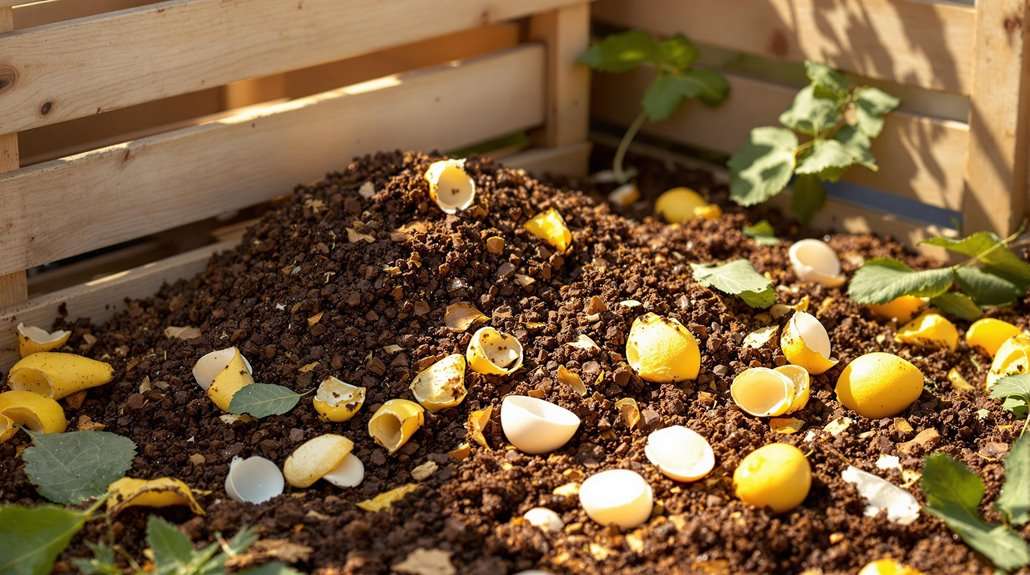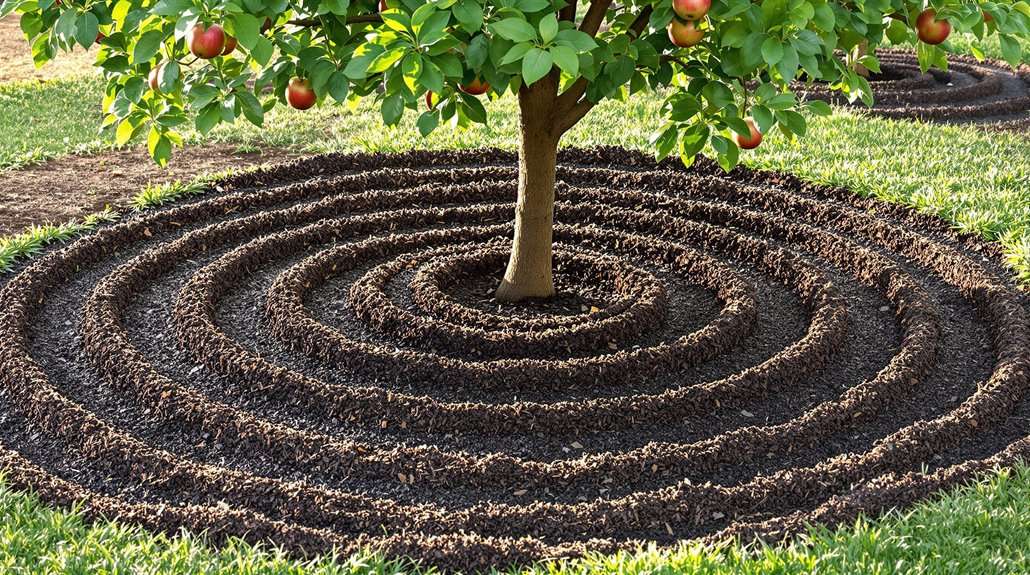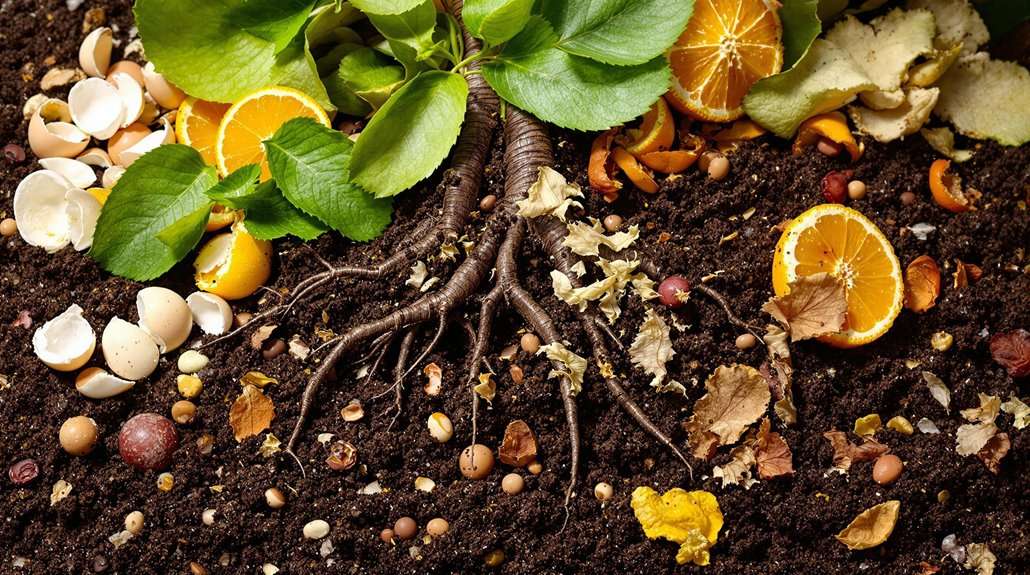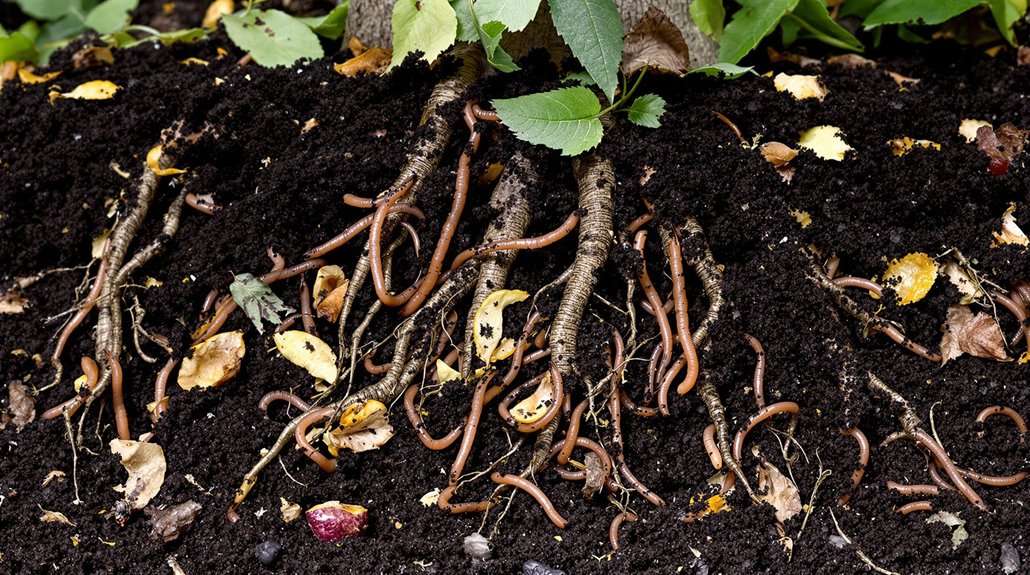Best Compost for Fruit Trees
You'll get the best results using a balanced compost mixture with both nitrogen-rich materials (kitchen scraps, coffee grounds) and carbon-rich materials (dry leaves, brown paper) in a 25:1 carbon-to-nitrogen ratio. Apply your compost in late fall or early spring, spreading it in a circle around the tree's drip line, keeping it 12-18 inches away from the trunk. Maintain a one-inch layer depth and combine it with wood mulch for ideal moisture retention and temperature regulation. Regular soil testing helps you monitor pH levels (aim for 6.0-6.5) and adjust nutrient content accordingly. There's much more to learn about maximizing your fruit trees' health through proper composting techniques.
This post may contain affiliate links. If you make a purchase through these links, I may earn a commission at no additional cost to you. Additionally, portions of this post may be generated using artificial intelligence (AI) technology. While we strive for accuracy, please be aware that AI-generated content may not always be perfect and should be fact-checked when necessary.
The Spatula Scoops
- Balanced compost should contain both nitrogen-rich materials (kitchen scraps, coffee grounds) and carbon-rich materials (dry leaves, brown paper) in a 25:1 ratio.
- Apply mature compost in a 2-4 inch layer around the tree's drip line, staying 12-18 inches away from the trunk.
- Choose compost with pH between 6.0-6.5 and organic matter content of 50-60% for optimal fruit tree nutrient absorption.
- Apply compost twice yearly, ideally in late fall and early spring, and water afterward to enhance nutrient absorption.
- Combine compost with wood mulch to improve moisture retention, regulate soil temperature, and provide long-term nutrient release.
Essential Compost Components

For successful fruit tree growth, your compost needs to contain a balanced mix of nitrogen-rich and carbon-rich materials. You'll find nitrogen-rich components in your everyday kitchen waste, including fruit and vegetable scraps, coffee grounds with their filters, and crushed eggshells. These materials provide the nutrients needed for robust leaf and stem development in your fruit trees. Healthy soil microbes help break down these materials and deliver essential nutrients directly to your fruit trees.
Your carbon-rich materials, which include dry leaves, plant stalks, and brown paper products, help create the proper structure and aeration in your compost pile. When using paper products, stick to uncolored, non-glossy materials like shredded cardboard and brown paper bags, making sure to remove any tape, staples, or adhesives. The quality of your compost depends on maintaining specific ratios and conditions. You'll want to keep moisture levels below 60% and guarantee organic matter makes up at least 40% of the dried mass. The carbon-to-nitrogen ratio shouldn't exceed 25:1, and you'll need to maintain a pH between 6.0 and 6.5, which is ideal for fruit tree soils. Regular testing of your compost's nutrient content will help you achieve these prime conditions.
Seasonal Application Guide
Timing plays an essential role in successful fruit tree cultivation, with late fall and early spring being the ideal seasons for compost application. You'll find that applying compost during these periods helps your trees maximize nutrient uptake while supporting their natural growth cycles. While you can technically add compost year-round, following a twice-yearly schedule guarantees superior results.
For the best outcome, you'll want to spread your compost in a neat circle around the tree's drip line, being careful not to pile it against the trunk. Animal manure can serve as an excellent organic mulch alternative. Don't dig or till the compost into the soil, as this can damage the tree's surface roots. Instead, sprinkle it in shallow holes and cover with additional compost for efficient nutrient delivery.
If you're working with young fruit trees, they'll need consistent, balanced nutrients throughout their growing season. You can supplement your spring and fall applications with an early summer feeding to support their development. Remember to use well-decomposed compost and consider layering it with other organic mulches like wood chips or straw to enhance nutrient availability and prevent nitrogen depletion.
Proper Spreading Techniques

Spreading Distance and Depth
Proper compost spreading techniques guarantee your fruit trees receive perfect nutrients while maintaining healthy root systems. You'll want to maintain a distance of 12 to 18 inches from the trunk when spreading compost, creating a uniform circle that extends to the tree's canopy edge. Keep the layer 1 to 2 inches thick for ideal insulation and weed prevention, but never let it contact the trunk directly to avoid rot. Early spring applications of compost provide optimal vegetative growth.
| Tree Size | Compost Amount | Application Frequency |
|---|---|---|
| Small (<10ft) | 1 cubic foot | Twice yearly |
| Medium (10-20ft) | 2 cubic feet | Twice yearly |
| Large (>20ft) | 3+ cubic feet | Twice yearly |
| Young Fruit | 0.5 cubic foot | Three times yearly |
| Mature Fruit | 2 cubic feet | Twice yearly |
When layering your compost, consider combining it with wood mulch for enhanced benefits. Start with your nutrient-rich compost layer, then top it with wood chips or bark mulch. This combination provides excellent root insulation while ensuring proper nutrient delivery. You'll find this method particularly effective for fruit trees, as it maintains consistent soil moisture and temperature while gradually releasing nutrients into the soil.
Tools and Application Steps
For successful compost application around fruit trees, you'll need the right tools and a systematic approach. Start by gathering your wheelbarrow to transport the compost and a shovel for even distribution. Don't forget your gardening gloves to protect your hands while handling the material. Avoid using hoes or aerators, as these can damage the delicate surface roots of your fruit trees. The ideal layer thickness is 3-4 inches to prevent potential issues with root rot.
Before you begin spreading, verify your compost is fully decomposed and ready for use. It should smell earthy, like fresh soil, without any visible chunks of raw organic matter. Here's your step-by-step application process:
- Transport your mature compost to the tree using your wheelbarrow
- Create a circular zone 12-18 inches from the trunk for spreading
- Use your shovel to distribute the compost evenly around the tree
- Water the area thoroughly to help integrate the compost into the soil
Remember to maintain a consistent layer without piling the compost against the tree trunk. You can add a layer of wood mulch on top of the compost for additional benefits, creating a nutrient-rich environment that'll support your tree's growth throughout the season.
Nutrient Benefits for Fruit Trees
The richness of compost offers fruit trees a complete package of essential nutrients for ideal growth and production. When you incorporate compost into your soil, you're providing your trees with nitrogen for leaf growth, phosphorus for root development, and potassium for fruit production, all released gradually over time. This slow-release mechanism prevents nutrient leaching and guarantees your trees receive sustained nourishment throughout the growing season.
You'll find that compost's benefits extend beyond just primary nutrients. The organic matter improves your soil's structure, enhancing its ability to retain water and nutrients while promoting beneficial microbial activity. These microorganisms break down organic materials, making nutrients more accessible to your fruit trees' root systems. Additionally, you're supplementing your soil with crucial trace minerals that synthetic fertilizers often lack.
Mulch Layering Methods

Successful mulch layering begins with understanding proper depth and coverage for your fruit trees. You'll want to maintain a 1-2 inch layer of compost spread evenly under the tree's canopy, being careful not to let it touch the trunk. By combining different types of mulch, you're creating an ideal environment for root growth and nutrient absorption.
Here's your essential layering sequence for maximum benefits:
- Start with a base layer of nutrient-rich compost or well-rotted manure, spreading it 1-2 inches thick
- Add a thin layer of organic granulated fertilizer for an extra nutrient boost
- Cover with wood chips or other woody mulch for insulation and weed control
- Verify the entire layer system stays at least 3 inches away from the trunk
You'll get the best results by applying your mulch layers twice yearly – once in early spring before the last frost and again in early summer. If you're using mushroom compost, consider adding powdered sulfur to balance the pH. Remember that thicker isn't always better; excessive mulch depth can lead to water retention issues that may damage your tree's roots.
Common Application Mistakes
Mastering proper compost application requires understanding common pitfalls that can harm your fruit trees. When you're applying compost, you'll need to contemplate timing, technique, and quality to guarantee ideal results.
| Common Mistake | How to Avoid It |
|---|---|
| Applying too close to trunk | Spread 12-18 inches away from base |
| Using undecomposed material | Verify complete breakdown before use |
| Incorrect seasonal timing | Apply before last frost and early summer |
You'll want to avoid overapplication, which can lead to excessive leaf growth at the expense of fruit production. Don't make the mistake of tilling under your trees, as this can damage surface roots and cause fruit drop. Instead, spread your compost in an even layer about one inch thick, and make certain you're adjusting the amount based on your tree's size.
Remember to test your soil regularly and monitor your tree's health to make necessary adjustments. Different fruit trees have varying nutrient needs, so you shouldn't rely solely on compost. Keep records of your applications and watch for signs of nutrient deficiencies or excesses, particularly when using materials like mushroom compost that might have high salt content.
Organic Compost Alternatives

When you're looking for natural compost alternatives, you'll find that plant-based options, such as kitchen scraps and yard waste, can provide excellent nutritional benefits while promoting healthy soil microbiology in your fruit tree garden. Animal-based fertilizers, particularly composted chicken and livestock manure, offer concentrated nutrients that release slowly into the soil, making them ideal supplements for fruit trees throughout their growing cycle. You can maximize results by combining both plant and animal-based materials in your composting strategy, creating a balanced approach that supports long-term soil health and fruit production.
Natural Plant-Based Options
For fruit tree growers seeking natural alternatives to traditional compost, several plant-based options provide excellent nutrition while maintaining organic growing principles. You'll find that these materials break down slowly, offering a consistent supply of nutrients while improving your soil's structure and mineral content. Products like Natural Wonder Mix provide an ideal organic base for fruit trees.
- Alfalfa meal works as an excellent nitrogen source for your fruit trees, and it's particularly effective when mixed with your existing soil, providing both immediate and long-term nutritional benefits
- Kelp meal delivers essential trace minerals and micronutrients that aren't commonly found in standard composts, helping to prevent deficiencies in your trees
- Soybean and cottonseed meals offer balanced nutrition with a focus on nitrogen, which you'll need for strong leaf and fruit development
- Green sand serves as both a soil conditioner and potassium source, improving your soil's structure while feeding your trees
You can enhance these plant-based options by incorporating them into your existing soil or combining them with other organic amendments. Consider adding calcium supplements if you're growing fruits like apples or pears, as they'll benefit from the additional mineral support.
Animal Fertilizer Benefits
Animal-based fertilizers offer compelling advantages for fruit tree cultivation, particularly when compared to synthetic alternatives. You'll find that composted manure considerably enhances your soil's structure while providing a balanced mix of essential nutrients that your fruit trees need for peak growth. The organic matter in animal manure improves water retention and drainage, creating an ideal environment for root development. Spring application is optimal for maximum nutrient absorption as trees begin their active growing phase.
When you're using animal fertilizers, you'll notice they release nutrients gradually, with about 30-50% of nitrogen becoming available in the first year. This slow-release characteristic helps prevent nutrient leaching and provides sustained nourishment for your trees. You'll want to verify your manure is properly composted before application, as this process eliminates potential pathogens and creates a more stable nutrient profile. Apply the composted manure around your tree's drip line, where the feeder roots can efficiently absorb the nutrients.
To maximize benefits, you should conduct regular soil tests to monitor nutrient levels and adjust your application rates accordingly. This approach not only supports healthy fruit production but also promotes long-term soil fertility and reduced dependency on chemical fertilizers.
Soil Testing and Amendments
To optimize your fruit tree's growth through composting, you'll need to start with proper soil testing and amendments. Understanding your soil's current condition will help you determine the right compost mixture and application methods. Before adding any compost, test your soil's pH levels, which should ideally fall between 6.0 and 6.5 for fruit trees. Beneficial organisms will naturally populate your soil when using quality compost, improving overall tree health.
- Test your soil's organic matter content – you'll want to achieve 50-60% after composting to guarantee proper nutrient availability
- Monitor the carbon-to-nitrogen ratio, aiming for 15:1 to 25:1 to prevent nitrogen deficiency
- Check electrical conductivity (EC) levels to avoid salt damage to your trees
- Conduct emergence tests to detect any harmful herbicide residues
When applying amendments, spread a 2- to 4-inch layer of compost under your tree's canopy, but keep it away from the trunk. Don't till the compost into the soil, as this can damage the root system. Late fall or early winter applications work best, though you can add compost any time. For maximum benefit, consider combining your compost with a mulch layer to improve soil quality and water retention while suppressing weed growth.
Pest Management Through Composting

While proper soil testing sets the foundation for healthy fruit trees, effective composting practices can greatly reduce pest problems in your orchard. You'll find that applying compost at depths of 6-12 cm can notably suppress weed growth, while also creating an environment that's less hospitable to common fruit tree pests like woolly apple aphids and spotted tentiform leafminers. Recent studies from British Columbia trials demonstrate that compost outperforms raw manure in controlling pests while improving soil properties.
| Pest Type | Compost Effect | Management Strategy |
|---|---|---|
| Fungal Disease | Slows brown rot growth | Apply 40 dry tons/acre |
| Insects | Reduces harmful populations | Combine with sticky traps |
| Weeds | Suppresses growth | Maintain 6-12 cm depth |
When you're managing pests through composting, you'll want to focus on proper application methods. Using products like Big Horn Natural Compost or similar varieties at about 40 dry tons per acre will give you best results. For the most effective pest control, you should integrate composting with other management strategies, such as pheromone traps and biological controls. While the initial cost of compost application (around $700/acre) might seem considerable, you'll typically see long-term benefits that outweigh traditional fumigation methods, especially when considering the improved soil health and reduced need for chemical pesticides.
Frequently Asked Questions
Can I Use Fresh Grass Clippings as Compost for My Fruit Trees?
You shouldn't use fresh grass clippings directly as compost for fruit trees, as they need proper decomposition first. Instead, mix your clippings with brown materials like dried leaves or cardboard in your compost pile. When composting, keep the clippings away from tree trunks, layer them thinly, and maintain proper moisture. Once fully decomposed, you'll have nutrient-rich compost that's safe for your fruit trees.
How Long Should Compost Age Before Applying It to Fruit Trees?
While you might be keen to use your compost quickly, you'll need to age it for 6-12 months before applying it to your fruit trees. You'll know it's ready when it has a dark, crumbly texture and an earthy smell with no visible raw materials. If you're using hot composting methods with proper temperature monitoring and regular turning, you might achieve finished compost in about 3-4 months.
Will Adding Coffee Grounds to Fruit Tree Compost Increase Soil Acidity?
Yes, coffee grounds will increase soil acidity when added to your fruit tree compost. However, you'll need to manage the quantity carefully. Coffee grounds typically have a pH of 5.5-6.8, and while many fruit trees enjoy slightly acidic soil, too much can be harmful. You can balance the acidity by mixing coffee grounds with brown materials like leaves or cardboard in your compost. It's best to add them gradually rather than all at once.
Can I Use Compost From Diseased Vegetable Plants Around Fruit Trees?
While you might think composting is about recycling all garden waste, you shouldn't use diseased vegetable plant material in compost for your fruit trees. These diseased materials can spread pathogens to your healthy trees, potentially causing root damage, reduced yields, and long-term soil contamination. Instead, use compost made from healthy plant materials, or try alternatives like clean wood chip mulch layered with disease-free compost to nourish your trees safely.
Does Compost Application Timing Differ for Young Versus Mature Fruit Trees?
Yes, timing differs greatly between young and mature fruit trees. You'll want to apply compost to young trees in late fall or early winter to prepare for the growing season, while mature trees benefit from bi-annual applications in early spring and late summer. For young trees, focus on single applications to avoid overwhelming the developing root system, whereas mature trees can handle more frequent feeding due to their established root networks.





